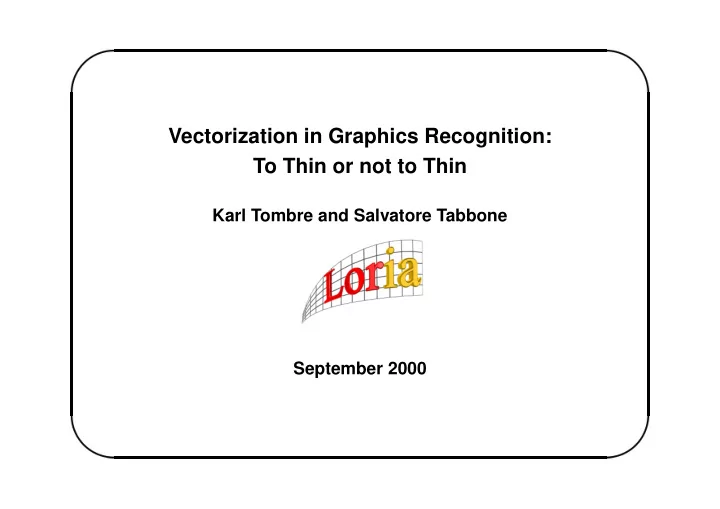

' $ Vectorization in Graphics Recognition: To Thin or not to Thin Karl Tombre and Salvatore Tabbone September 2000 & %
' $ To Thin or not to Thin Graphics recognition Graphics recognition Analysis of graphics-intensive documents Main feature = the vector ⇒ raster-to-vector conversion plays a & % central rôle Karl Tombre 1
' $ To Thin or not to Thin Graphics recognition � � � � Choice of vectorization method Compute a medial axis or not? ➥ medial axis computations are classical for image processing people ➥ skeletons often used ➥ faithful representation of binary shape � = retrieve actual thoughts of draftsman ➥ Special problems with junctions and line extremities & % Karl Tombre 2
' $ To Thin or not to Thin Graphics recognition � � � � The steps of vectorization ➊ Find the lines ← ➋ Approximate the lines into vectors ➥ Rosin & West split and merge ➥ Wall & Danielsson iterative ➌ Add contextual information ➍ Dashed-line detection ➎ Arc detection → poster presented yesterday & % Karl Tombre 3
' $ To Thin or not to Thin Finding the lines Finding the lines From raster image to lines (chains of pixels) → significant medial axes ➊ Compute the skeleton • iterative thinning • distance transform ➋ Match the opposite sides of the line ➌ Sparse-pixel approaches & % Karl Tombre 4
' $ To Thin or not to Thin Skeletonization Skeletonization Iterative thinning : “peeling an onion” ⌣ small image buffer size & % ⌢ multiple passes, sensitive to noise Karl Tombre 5
' $ To Thin or not to Thin Skeletonization Distance transform : 3–4 DT [Sanniti di Baja] V 2 V 3 V 4 Pass 1 : Y = min( V 1 + 3 , V 2 + 4 , V 3 + 3 , V 4 + 4) V 1 X V 5 Pass 2 : Z = min( Y, V 5 +3 , V 6 +4 , V 7 +3 , V 8 +4) V 8 V 7 V 6 • Detection of local maxima • Tracking the skeleton • Reduce to thickness 1 • Barb removal → good compromise w.r.t. precision, simplicity and robustness & % Karl Tombre 6
' $ To Thin or not to Thin Skeletonization � � � � Linking the skeleton 3 1 4 2 & % Karl Tombre 7
' $ To Thin or not to Thin Skeletonization � � � � Main weakness Skeletonization displaces junction points & % Original image Polygonal approximation of 2–3 skeleton Karl Tombre 8
To Thin or not to Thin Matching opposite contours ' $ Matching opposite contours REDRAW: polygonal approximation of connected components contours, and match segments junction point Problems: thresholds, one-to-many and many-to-many matches & % Karl Tombre 9
' $ To Thin or not to Thin Matching opposite contours � � � � Improvement: use the gradient orientation Gradient vector (Canny operator) perpendicular to contour ⇒ dense and robuste matching of each contour point in the direction of the gradient Contour detection “Skeleton” obtained by dense matching & % Karl Tombre 10
' $ To Thin or not to Thin Matching opposite contours � � � � The steps of vectorization ➊ Find the lines ➋ Approximate the lines into vectors ➥ Rosin & West split and merge ➥ Wall & Danielsson iterative ➌ Add contextual information ← ➍ Dashed-line detection ➎ Arc detection → poster presented yesterday & % Karl Tombre 11
' $ To Thin or not to Thin Contextual information Contextual information Add domain knowledge ✓ specific documents → ad hoc vectorization (e.g. [Chhabra]) ✓ heuristic correction → adds new thresholds and parameters ✓ add constraints [Röösli & Monagan] ✓ optimize junction position through iterative fitting [Janssen] ✓ introduce models of ideal junctions (T, L, Y . . . ) and correct by fitting & % Karl Tombre 12
' $ To Thin or not to Thin Contextual information � � � � Knowing what you look for The case of architectural drawings: looking for the walls Dense contour-matching followed by search for horizontal and vertical rectangles Reconstructed rectangles Medial axes of rectangles & % Karl Tombre 13
' $ To Thin or not to Thin Discussion Discussion ➥ Contour-matching + contextual information yield good results... ➥ ... but in general case, contextual information not exhaustive ➥ Skeletonization is generic and robust, but yields weak junctions ➥ skeleton: emphasizes distance criterion ➥ dense matching: emphasizes direction criterion & % Karl Tombre 14
' $ To Thin or not to Thin Discussion � � � � A possible solution Three-step vectorization under study: ➥ first crude vectorization to segment a drawing into pieces having same direction ➥ directional distance transforms on each piece ➥ junction models for better precision at intersections & % Karl Tombre 15
' $ To Thin or not to Thin Conclusion Conclusion ✓ Skeletons still most general and generic ✓ Junctions and extremities still not satisfactory ✓ Combine directional and distance criteria ✓ Keep an eye on emerging methods (Markov Random Fields, ...) & % Karl Tombre 16
Recommend
More recommend